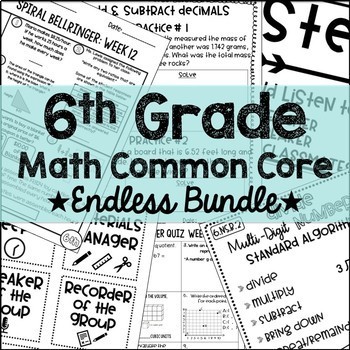6th Grade Math Common Core GROWING Bundle

What educators are saying
Products in this Bundle (76)
showing 1-5 of 76 products
Description
This GROWING BUNDLE is a perfect solution for the busy 6th grade math teacher! This bundle includes notes, quizzes, tests, spiral bellringers, classroom decor, and activities directly aligned to the 6th Grade Math Common Core State Standards. You will also receive items that ARE NOT in my store that I use in my classroom only. Stop spending your time searching for things on the internet and use your time for you!
This bundle will continue to grow! Every time I put a new product in the bundle the price will go up, so make sure to buy now to save money! I will add several new products every month!
Look below for the products that are included.
How do I download new products when I have purchased this bundle?
Once you have purchased this bundle, continue to check in your "purchases section" for new updates on this product. Then re-download the product. Check back a few times a month for an update!
Do you want to see how I use these products in the classroom?
Click the link below for my Instagram account!
● ● ● ● ● ● ● ● ● ● ● ● ● ● ● ● ● ● ● ● ● ● ● ● ● ● ● ● ● ● ● ● ● ● ● ● ● ● ● ● ● ● ● ● ● ● ● ● ● ●
Customer Tips:
How to get TPT credit for future purchases:
Go to your "My Purchases" page. Next to each purchase. You'll see a "Provide Feedback" button. Simply click it and you will be taken to a page where you can give a quick rating and leave a short comment for the product. Each time you give feedback, TPT gives you feedback credits that you may use to lower the cost of your future purchases. I would be VERY grateful for your feedback. Feedback is so VERY important!


